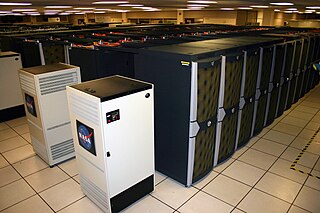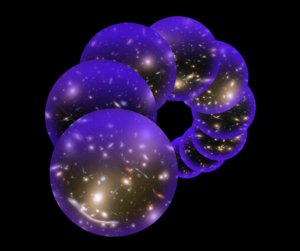The study of galaxy formation and evolution is concerned with the processes that formed a heterogeneous universe from a homogeneous beginning, the formation of the first galaxies, the way galaxies change over time, and the processes that have generated the variety of structures observed in nearby galaxies. Galaxy formation is hypothesized to occur from structure formation theories, as a result of tiny quantum fluctuations in the aftermath of the Big Bang. The simplest model in general agreement with observed phenomena is the Lambda-CDM model—that is, that clustering and merging allows galaxies to accumulate mass, determining both their shape and structure. Hydrodynamics simulation, which simulates both baryons and dark matter, is widely used to study galaxy formation and evolution.

Astronomy is a natural science that studies celestial objects and the phenomena that occur in the cosmos. It uses mathematics, physics, and chemistry in order to explain their origin and their overall evolution. Objects of interest include planets, moons, stars, nebulae, galaxies, meteoroids, asteroids, and comets. Relevant phenomena include supernova explosions, gamma ray bursts, quasars, blazars, pulsars, and cosmic microwave background radiation. More generally, astronomy studies everything that originates beyond Earth's atmosphere. Cosmology is a branch of astronomy that studies the universe as a whole.
In cosmology and physics, cold dark matter (CDM) is a hypothetical type of dark matter. According to the current standard model of cosmology, Lambda-CDM model, approximately 27% of the universe is dark matter and 68% is dark energy, with only a small fraction being the ordinary baryonic matter that composes stars, planets, and living organisms. Cold refers to the fact that the dark matter moves slowly compared to the speed of light, giving it a vanishing equation of state. Dark indicates that it interacts very weakly with ordinary matter and electromagnetic radiation. Proposed candidates for CDM include weakly interacting massive particles, primordial black holes, and axions.

The observable universe is a ball-shaped region of the universe comprising all matter that can be observed from Earth or its space-based telescopes and exploratory probes at the present time; the electromagnetic radiation from these objects has had time to reach the Solar System and Earth since the beginning of the cosmological expansion. Initially, it was estimated that there may be 2 trillion galaxies in the observable universe. That number was reduced in 2021 to only several hundred billion based on data from New Horizons. Assuming the universe is isotropic, the distance to the edge of the observable universe is roughly the same in every direction. That is, the observable universe is a spherical region centered on the observer. Every location in the universe has its own observable universe, which may or may not overlap with the one centered on Earth.
In physical cosmology, structure formation is the formation of galaxies, galaxy clusters and larger structures from small early density fluctuations. The universe, as is now known from observations of the cosmic microwave background radiation, began in a hot, dense, nearly uniform state approximately 13.8 billion years ago. However, looking at the night sky today, structures on all scales can be seen, from stars and planets to galaxies. On even larger scales, galaxy clusters and sheet-like structures of galaxies are separated by enormous voids containing few galaxies. Structure formation attempts to model how these structures were formed by gravitational instability of small early ripples in spacetime density or another emergence.
The Millennium Run, or Millennium Simulation is a computer N-body simulation used to investigate how the distribution of matter in the Universe has evolved over time, in particular, how the observed population of galaxies was formed. It is used by scientists working in physical cosmology to compare observations with theoretical predictions.

Interacting galaxies are galaxies whose gravitational fields result in a disturbance of one another. An example of a minor interaction is a satellite galaxy disturbing the primary galaxy's spiral arms. An example of a major interaction is a galactic collision, which may lead to a galaxy merger.

Carlos Silvestre Frenk is a Mexican-British cosmologist. Frenk graduated from the National Autonomous University of Mexico and the University of Cambridge, and spent his early research career in the United States, before settling permanently in the United Kingdom. He joined the Durham University Department of Physics in 1986 and since 2001 has served as the Ogden Professor of Fundamental Physics at Durham University.

Galaxy mergers can occur when two galaxies collide. They are the most violent type of galaxy interaction. The gravitational interactions between galaxies and the friction between the gas and dust have major effects on the galaxies involved. The exact effects of such mergers depend on a wide variety of parameters such as collision angles, speeds, and relative size/composition, and are currently an extremely active area of research. Galaxy mergers are important because the merger rate is a fundamental measurement of galaxy evolution. The merger rate also provides astronomers with clues about how galaxies bulked up over time.
The simulation hypothesis proposes that what humans experience as the world is actually a simulated reality, such as a computer simulation in which humans themselves are constructs. There has been much debate over this topic, ranging from philosophical discourse to practical applications in computing.
The Virgo Consortium was founded in 1994 for Cosmological Supercomputer Simulations in response to the UK's High Performance Computing Initiative. Virgo developed rapidly into an international collaboration between a dozen scientists in the UK, Germany, Netherlands, Canada, United States and Japan.

Pleiades is a petascale supercomputer housed at the NASA Advanced Supercomputing (NAS) facility at NASA's Ames Research Center located at Moffett Field near Mountain View, California. It is maintained by NASA and partners Hewlett Packard Enterprise and Intel.
Brain simulation is the concept of creating a functioning computer model of a brain or part of a brain. Brain simulation projects intend to contribute to a complete understanding of the brain, and eventually also assist the process of treating and diagnosing brain diseases.
Eris is a computer simulation of the Milky Way galaxy's physics. It was done by astrophysicists from the Institute for Theoretical Physics at the University of Zurich, Switzerland and University of California, Santa Cruz. The simulation project was undertaken at the NASA Advanced Supercomputer Division's Pleiades and the Swiss National Supercomputing Centre for nearly eight months, which would have otherwise taken 570 years in a personal computer. The Eris simulation is the first successful detailed simulation of a Milky Way like galaxy. The results of the simulation were announced in August 2011.

Computational astrophysics refers to the methods and computing tools developed and used in astrophysics research. Like computational chemistry or computational physics, it is both a specific branch of theoretical astrophysics and an interdisciplinary field relying on computer science, mathematics, and wider physics. Computational astrophysics is most often studied through an applied mathematics or astrophysics programme at PhD level.

The Institute for Computational Cosmology (ICC) is a Research Institute at Durham University, England. It was founded in November 2002 as part of the Ogden Centre for Fundamental Physics, which also includes the Institute for Particle Physics Phenomenology (IPPP). The ICC's primary mission is to advance fundamental knowledge in cosmology. Topics of active research include: the nature of dark matter and dark energy, the evolution of cosmic structure, the formation of galaxies, and the determination of fundamental parameters.
The Bolshoi simulation, a computer model of the universe run in 2010 on the Pleiades supercomputer at the NASA Ames Research Center, was the most accurate cosmological simulation to that date of the evolution of the large-scale structure of the universe. The Bolshoi simulation used the now-standard ΛCDM (Lambda-CDM) model of the universe and the WMAP five-year and seven-year cosmological parameters from NASA's Wilkinson Microwave Anisotropy Probe team. "The principal purpose of the Bolshoi simulation is to compute and model the evolution of dark matter halos, thereby rendering the invisible visible for astronomers to study, and to predict visible structure that astronomers can seek to observe." “Bolshoi” is a Russian word meaning “big.”
The University of California High-Performance AstroComputing Center (UC-HiPACC) based at the University of California at Santa Cruz (UCSC) is a consortium of nine University of California campuses and three Department of Energy laboratories. The consortium's goal is to support and facilitate original research and education in computational astrophysics and to engage in public outreach and education.
The Illustris project is an ongoing series of astrophysical simulations run by an international collaboration of scientists. The aim was to study the processes of galaxy formation and evolution in the universe with a comprehensive physical model. Early results were described in a number of publications following widespread press coverage. The project publicly released all data produced by the simulations in April, 2015. Key developers of the Illustris simulation have been Volker Springel and Mark Vogelsberger. The Illustris simulation framework and galaxy formation model has been used for a wide range of spin-off projects, starting with Auriga and IllustrisTNG followed by Thesan (2021), MillenniumTNG (2022) and TNG-Cluster.
Alyson Brooks is an American theoretical astrophysicist and professor at Rutgers University. She uses large-scale simulations to determine how galaxies form.









